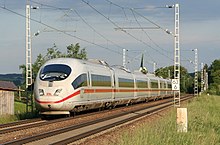Special kinds of trains running on corresponding special 'railways' are atmospheric railways, monorails, high-speed railways, maglev, rubber-tired underground, funicular and cog railways.
A passenger train may consist of one or several locomotives, and one or more coaches. Alternatively, a train may consist entirely of passenger carrying coaches, some or all of which are powered as a "multiple unit". In many parts of the world, particularly Japan and Europe, high-speed rail is utilized extensively for passenger travel.
Freight trains comprise wagons or trucks rather than carriages, though some parcel and mail
trains (especially Travelling Post Offices) are outwardly more like passenger trains.
Trains can also be 'mixed', comprising both passenger accommodation and freight vehicles. Such mixed trains are most likely to occur where services are infrequent, and running separate passenger and freight trains is not cost-effective, though the differing needs of passengers and freight usually means this is avoided where possible.
Special trains are also used for track maintenance; in some places, this is called maintenance of

way.
In the United Kingdom, a train hauled by two locomotives is said to be "double-headed", and in Canada and the United States it is quite common for a long freight train to be headed by three or more locomotives. A train with a locomotive attached at each end is described as 'top and tailed', this practice typically being used when there are no reversing facilities available. Where a second locomotive is attached temporarily

to assist a train up steep banks or grades (or down them by providing braking power) it is referred to as 'banking' in the UK, or 'helper service' in North America. Recently, many loaded trains in the US have been made up with one or more locomotives in the middle or at the rear of the train, operated remotely from the lead cab. This is referred to as "DP" or "Distributed Power."





0 comments:
Post a Comment